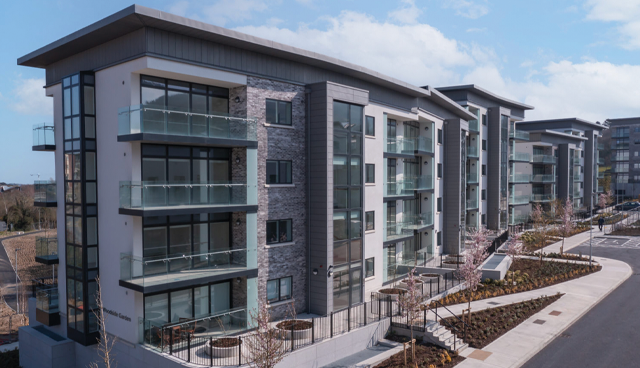
Town Centre First: Varying supply
4th July 2022
2022: A defining year for housing
4th July 2022Cost rental at scale

Delivered by Clúid Housing, the first cost rental houses in the State, at Taylor Hill in Balbriggan, County Dublin, were tenanted in 2021. Credit: Clúid Housing
Described in Housing for All as “the most radical reform of the Irish rental system in the history of the State”, cost rental housing offers an alternative model to rent rates based on profit maximisation. Now, however, the challenge for government is delivering it at scale.
Under the Government’s cost rental scheme, initial rents are set to match the cost of financing, building, managing, and maintaining homes, over a minimum period of 40 years. Increases in these rent rates will also be linked to annual inflation, “providing greater cost certainty and meaning that the initial cost rents may become even more affordable over time”.
Cost rental is targeted at households with incomes which exceed the threshold for social housing (below a net household income of €53,000) and aims to provide tenants with significantly increased security of tenure. Indeed, once a tenant has occupied a cost rental dwelling for six months, termination of their tenancy can only occur under limited conditions. The intention is that the delivery of cost rental at scale will stabilise the wider rental market.
Through the provision of “focused funding supports”, government intends to support local authorities, AHBs, and the LDA to provide rental homes “in the order of 25 per cent below market rents”, or, in other words, at least 25 per cent below market rents.
Legislative framework
Providing a legislative framework for cost rental homes, Part 3 of the Affordable Housing Act 2021, details: “In setting, at any particular time, the rent under a cost rental tenancy, a rent shall not be provided for that is greater than the cost rental rent for that dwelling specified in subsection (4).”
Subsection (4) determines that “cost rental rent” means “the initial maximum rent, plus, an amount, calculated in such manner as the Minister may prescribe, to take account of any change in the Harmonised Index of Consumer Prices as published by the Central Statistics Office, or such other index as the Minister may prescribe, since the dwelling was designated as a cost rental dwelling”.
Context
Cost rental in Ireland was first proposed by the National Economic and Social Council (NESC) in its Housing in Ireland: Performance and Policy report, published in December 2004. In that report, NESC referenced Jim Kemeny’s distinction between profit renting and cost renting.
Cost renting, NESC outlined, was “a situation in which rents cover only the actual incurred costs of providing the dwelling”. In such scenarios, a maturation process occurs whereby cost rental begins to compete with profit renting and owner occupation. This materialises in falling real rents and increased waiting lists for cost rental housing.

In April 2022, the State’s first purpose-built cost rental homes were delivered by Respond and Tuath, in partnership with Dún Laoghaire-Rathdown Council, at the Woodside development on the Enniskerry Road, Dublin. Credit: Respond
Conducive to successful social housing schemes in several European countries, including Austria, Denmark, France, Finland, and the Netherlands, most famously, cost rental is utilised by the Vienna Model. Under the Vienna Model, housing associations are permitted to accrue limited profit.
National housing strategy
Unlike Rebuilding Ireland’s ambiguous Affordable Rental Scheme, Housing for All is the first national housing strategy to include cost rental, specifically its roll out at scale as a pathway to supporting homeownership and increasing affordability.
During the lifetime of Housing for All, the Government plans to deliver an average of 2,000 cost rental homes per annum with an overall target of 18,000 cost rental homes by 2030. As such, the overall average delivery ratio will be approximately one cost rental home for every two affordable purchase homes.
In 2021, several cost rental projects were undertaken in Ireland, including the Enniskerry Road Project; St Michael’s Estate, Inchicore, Dublin 8; and Shanganagh, County Dublin. However, despite a government commitment to deliver 350 cost rental homes in 2021, only 65 were delivered in full and tenanted.
Of these, 40 were located at Barnhall Meadows in Leixlip, County Kildare, and the remaining 25 at Taylor Hill in Balbriggan, County Dublin. All of these were acquired by Clúid Housing. More recently, in March 2022, a joint venture pilot cost rental project between Respond and Tuath Housing bore fruit when 50 purpose-built cost rental homes at Enniskerry Road in Dún Laoghaire-Rathdown were tenanted.
At the time of print (June 2022), cost rental homes have now been tenanted at Barnhall Meadows, Leixlip; Taylor Hill, Balbriggan; and Enniskerry Road, Stepaside. Cost Rental projects set to be completed and tenanted in 2022 include: Kilcarbery Grange, Clondalkin; Newcastle, County Dublin; Newbridge, County Kildare; and Parklands, Citywest, County Dublin.
Misconceptions
Yet, several misconceptions abound around cost rental. For instance, the Nevin Economic Research Institute has highlighted the misconception that every household pays the same rent everywhere for the same type of dwelling; and that cost rental is synonymous with social housing. Similarly, while the Vienna Model is the most renowned, there are a variety of viable cost rental models. Indeed, there are three different delivery models for cost rental in Ireland.
Delivery
Over the period up to 2026, Housing for All commits to the delivery of 10,000 cost rental homes in urban centres by local authorities, approved housing bodies (AHBs), and the Land Development Agency (LDA).
Local authorities
Local authorities can apply for Affordable Housing Fund (AHF) funding to cover the cost of delivering – either building or buying – cost rental homes themselves, or through a third-party on their behalf.
For instance, a “flagship project” for Dublin City Council at Emmet Road (formerly St Michael’s Estate) in Inchicore, Dublin, is awaiting the submission of a planning application with An Bord Pleanála in Q3 2022. The proposed development will exceed 500 units. Of these units, 70 per cent will be cost rental (the other 30 per cent being social housing). As the land being utilised is public land, rent rates will be calculated as per the cost of construction, management, and maintenance of the development.

Clúid Housing’s cost rental homes at Barnhall Meadows, Leixlip, County Kildare were launched in October 2021. Credit: Clúid Housing
Approved housing bodies
Through the Cost Rental Equity Loan (CREL) mechanism, which covers up to 30 per cent of the capital costs of a development, the Department of Housing, Local Government and Heritage has approved funding for the development of around 900 cost rental homes, to be delivered in 2022 and 2023 by approved housing bodies.
For example, completion of the pilot Woodside scheme at Enniskerry Road, Stepaside, County Dublin, marked the delivery of the first purpose-built cost rental homes in the State and has helped inform the financial model upon which CREL is based.
Jointly delivered by Respond and Tuath AHBs, in partnership with Dún Laoghaire-Rathdown County Council, the land for the Woodside scheme was provided by The Housing Agency and must be utilised for cost rental homes for a minimum 70 years. In total, the scheme delivered 155 homes, including 50 two-bedroom cost rental homes which rents of approximately 40 per cent below open-market rates.
Land Development Agency
As per Housing for All, the LDA is the State’s primary channel for the development of cost rental housing. The objective of the cost rental model employed by the LDA is to cap tenant expenditure on rent to approximately one-third of their net disposable income, as “a generally accepted level of housing cost affordability”.
The LDA’s Project Tosaigh – a market engagement initiative to unlock land with full planning permission that is not being developed by the private sector owners – has a target of delivering 5,000 new homes by 2026 for affordable cost rental or sale.
Through Project Tosaigh, the LDA will provide cost rental homes ahead of the direct delivery of homes on its own sites later in the decade. For instance, it has collaborated with Dún Laoghaire-Rathdown County Council at Shanganagh, County Dublin. The project at Shanganagh is the largest cost rental scheme to date, and, of the 597 units planned, 306 (51 per cent) are to be delivered as cost rental dwellings. Construction on the site is due to commence in September 2022.
Budget 2022
As per the Budget 2022: Expenditure Report, with a combination of Exchequer funding, Housing Finance Agency lending, and LDA investment funding, housing capital funding in 2022 totals over €4 billion.
Delivery of cost rental homes are intended to be delivered via several funding streams.
A total of €75 million is being allocated to the development of 750 cost rental homes in 2022. Of this figure, 700 are to be delivered by AHBs via €70 million provided by the Cost Rental Equity Loan (CREL) mechanism. Covering up to 30 per cent of capital costs of a housing development, CREL is administered by The Housing Agency, on behalf of DHLGH.
Responsibility for the additional 50 homes rests with the local authorities which will directly deliver them with support via €5 million provided by the Affordable Housing Fund (previously known as the Serviced Site Fund). Meanwhile, it is anticipated that LDA investment will underpin the delivery of over 1,000 cost rental and affordable purchases homes.
Opposition
However, in its Alternative Housing Budget 2022, Sinn Féin proposed the delivery of “4,000 affordable cost rental homes”, double the Housing for All figures, at a cost of €300 million during the year. This equates to €75,000 per unit, with the “remainder covered by loans from [the Housing Finance Agency], [and the European Investment Bank]”.
Dependent on household size and income, these homes, Sinn Féin asserted, would be available to rent for between €700 and €900 per month.
Latest discourse
Moving a private members’ motion on rising rental costs in May 2022, Sinn Féin’s housing spokesperson, Eoin Ó Broin TD asserted: “There has been a failure to deliver cost rental over the last three years with zero in the first year, 65 last year and possibly 700 this year depending on the numbers. It is nowhere close to the thousands that are required.
“Crucially, we need at least 4,000 cost rental tenancies annually. For decades, housing policy experts and advisers to Government have been saying we need cost rental on scale. The Minister is not even going to reach that scale at the end of 2026 because he is only targeting 2,000 units by then, which is nowhere close to enough.”
In response, Minister O’Brien maintained: “We have delivered cost rental from a slow start. It did not exist and was not here, but we legislated for it, which Sinn Féin supported. There are now tenants in place paying 50 per cent below the market rent in many places. We will deliver hundreds more such units this year.
“We have to build capacity in the construction sector to deliver the homes we need… The roll-out of cost rental is happening and will continue. We have funded more than 900 new tenancies for this year and, if we can do more, we will because resources are not an issue.”
Affordability
With cost rental, logic dictates that where construction, management, and maintenance costs are low, rents will also be low. Therefore, the inverse is also true. Where cost rental homes are expensive to construct, manage, and maintain, they will have higher rents. As a result, while some rent rates are considerably cheaper than the market rent, at a minimum they must be 25 per cent below market rent.
As such, the Government’s attempts to deliver affordable cost rental are being undermined by inflationary pressures and labour constraints in the construction sector. Consequently, rent rates for the cost rental projects in Clondalkin and City West, Dublin are set at €1,000 per month for one-bed apartments, €1,200 for two-bed apartments, €1,300 for two-bed duplexes. While this may mirror construction cost, it limits the discount that can be afforded to tenants. Ultimately, the result is that cost rental homes remain unaffordable for many middle-income earners.






